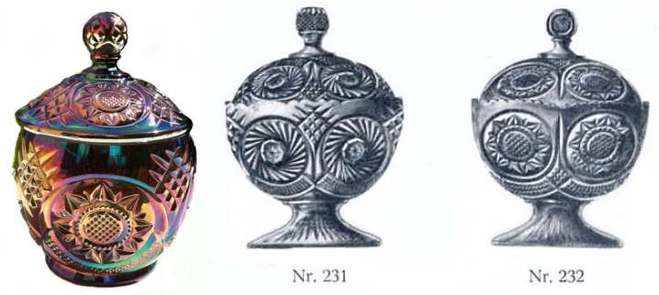The Kutzscher Design Gallery
Original or "Inspired" designs?
Kutzscher’s designs were a mixture of their new and original ideas and designs that were undoubtedly inspired by patterns and shapes which were already around at the time. "Inspired" is of course another way of saying "copied"! Sometimes the Kutzscher versions would be just a little bit different, but sometimes they would likely be close to the original designs.
It surely worked the other way too … it’s very likely that some glassmakers would have seen a Kutzscher drawing they admired and subsequently produced their own version of it themselves. Design protection was less than effective in the early 1900s, especially across national boundaries, and plagiarism was rife. So, with design registration in its infancy, a tweak here and a slight change there would create a “new” design. Time and again, looking at the glass patterns of the era, we see part of a design, a motif, a shape, and recognise that it’s familiar, that we have seen it before.
The Kutzscher Design Gallery
Here we feature the Carnival Glass patterns that we believe were produced from moulds made by Kutzscher. For some pieces, the finished Carnival piece is almost identical to the Kutzscher design. For other pieces, there are some subtle differences, indicating that the finished mould had been “customised” to meet the glassmakers' design requirements.
Kutzscher’s designs were a mixture of their new and original ideas and designs that were undoubtedly inspired by patterns and shapes which were already around at the time. "Inspired" is of course another way of saying "copied"! Sometimes the Kutzscher versions would be just a little bit different, but sometimes they would likely be close to the original designs.
It surely worked the other way too … it’s very likely that some glassmakers would have seen a Kutzscher drawing they admired and subsequently produced their own version of it themselves. Design protection was less than effective in the early 1900s, especially across national boundaries, and plagiarism was rife. So, with design registration in its infancy, a tweak here and a slight change there would create a “new” design. Time and again, looking at the glass patterns of the era, we see part of a design, a motif, a shape, and recognise that it’s familiar, that we have seen it before.
The Kutzscher Design Gallery
Here we feature the Carnival Glass patterns that we believe were produced from moulds made by Kutzscher. For some pieces, the finished Carnival piece is almost identical to the Kutzscher design. For other pieces, there are some subtle differences, indicating that the finished mould had been “customised” to meet the glassmakers' design requirements.
|
Edstrom, Eda
A little design tweak to give the customer individuality, and this Kutzscher design emerges as Eda Glasbruk’s Edstrom pattern. Note that this Kutzscher pattern is known as a covered stemmed sugar in marigold, called “Sunball” and found in Brazil (see Butters From Brazil, part 2). |
|
Stjarna, Eda
It’s fascinating to compare these two Kutzscher drawings (Nr. 231 and Nr. 232) with Eda's Stjarna bonbonniere. You can almost hear the conversation between glassmaker and mouldmaker: “I like the star on 232, but the crossed lines on 231 – can you mix and match the two for me? Oh yes, and lose the pedestal base too, please – we prefer a flat bottom”! |
|
Hobnail Banded, Riihimaki
Riihimaki were one of several glass makers that made Hobnail Banded tumblers – although to the best of our knowledge only Riihimaki did them in Carnival Glass. Although the blue tumbler shown is barrel shaped, others in Riihimaki’s catalogue were shown in exactly the same shape as that depicted in both early Riecke and later Kutscher catalogues. Interestingly, an almost identical tumbler was featured in Sowerby’s 1885 Pattern Book! |
|
Tulips, Hortensja It seems likely that the Kutzscher tulip drawing was the inspiration behind the Hortensja plate shown here; the implication being that this was a Kutzscher mould. It would appear that Kutzscher also made a similar mould for a slightly different version of the tulip drawing for Riihimaki too. This was in Riihimaki's 1939 catalogue, far right. |
|
Renaissance, Zabkowice Zabkowice in Poland made a range of shapes in the pattern we have named Renaissance, and seen here in the egg-shaped bonbonniere. Riecke’s 1905 book of drawings, and the subsequent Kutscher catalogues featured a butter dish in this pattern. See our Collectors Facts for much more about this intriguing design. |
In the next two sections of our four page feature on Kutzscher we look specifically at:
Kutzscher and Brockwitz: Original or Inspired designs?
Kutzscher - Some Questions: We investigate.
Or ... return to The Kutzscher Story
Click on any image below
Kutzscher and Brockwitz: Original or Inspired designs?
Kutzscher - Some Questions: We investigate.
Or ... return to The Kutzscher Story
Click on any image below












